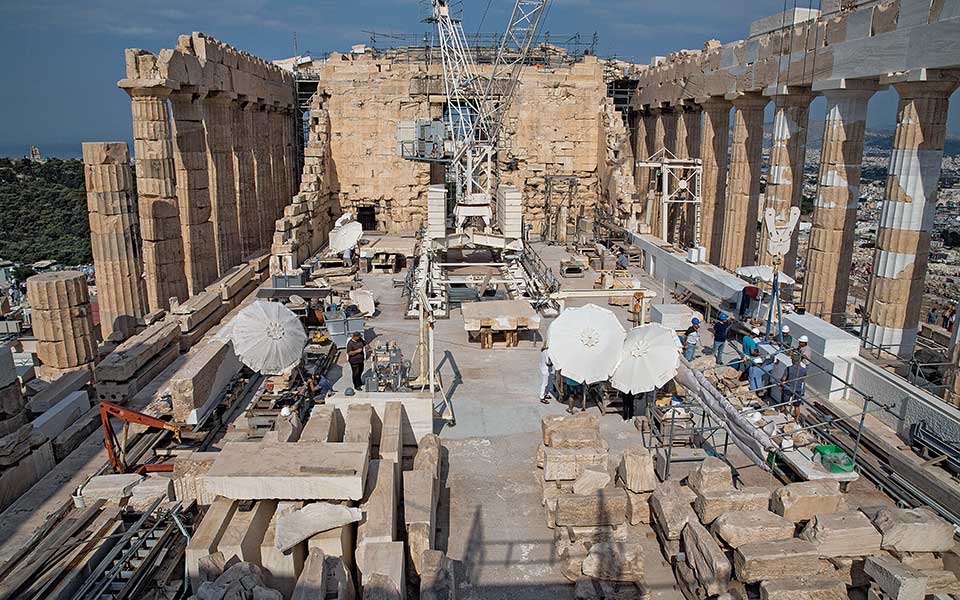We’re standing on the Acropolis, having just left the Propylaia behind us. Immediately, our gaze is drawn to the greatest achievement of ancient Greek architecture – the Parthenon. Everyone pauses, admiring the temple’s proportions, its harmony of lines, unsurpassed for two and a half thousand years. Most visitors capture this moment with a photograph; I pause to recall the words of Panos Valavanis, archaeology professor, who told me years ago that this monumental building is filled with symbolism evoking power, struggle and victory. Through it, he noted, passed the state ideology of ancient Athens.
Construction of the Parthenon took place between 447 BC and 438 BC, using marble from the quarries of Mt Penteli. It comprises 16,500 marble members of different sizes. About 600 skilled laborers and 150 marble workers were involved in the original transport of this material to the Acropolis. Among them was probably Socrates. As a young man, he had worked as a stonemason, like his father, before abandoning this occupation “for the sake of education,” as Lucian wrote.
Today, the area is again a construction site, and again it is full of workers. Inside the monument, dwarfed by the temple’s imposing columns, they look like colorful specks from afar. Among them, a small, lively female figure can be made out. A closer look reveals her to be architect Vasiliki Eleftheriou, director of the Acropolis Restoration Service (YSMA), the special department within the Ministry of Culture and Sports, established in 1999 for the purpose of organizing and implementing the conservation and restoration works to be carried out on the Acropolis. Since 1975, the Committee for the Conservation of the Acropolis Monuments (ESMA), a multidisciplinary committee of academics and governmental officials, has been responsible for the scientific work on the archaeological site.
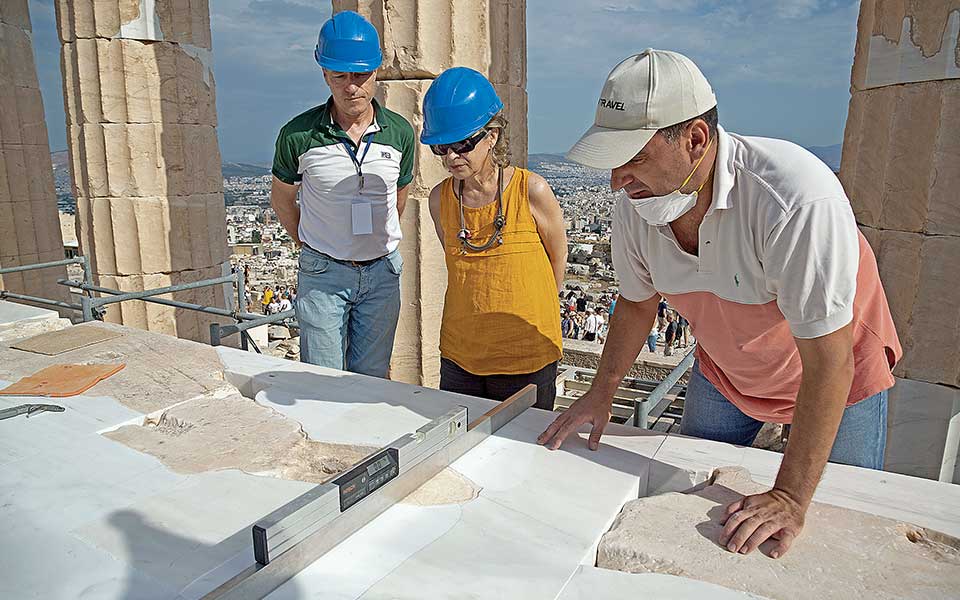
© Nikos Pilos
As with everyone on the team, the excitement and passion she has for the work she’s doing shows on her face, despite the glare of the fierce sun. Now that the restorations of the Erechtheion, Propylaia and Temple of Athena Nike have been completed, YSMA has focused in recent years on the Parthenon and Acropolis walls projects. Eleftheriou notes that the outline, which is still being followed today, for interventions on the Parthenon was first established in 1983 by architect Manolis Korres, current ESMA president.
In the coolness of her Plaka office, on quiet Polygnotou, near the Ancient Agora, we begin our conversation by referring to the “very important” meeting of the Central Archaeological Council (KAS) in early May. After a lengthy discussion, new proposals for the reconstruction of the north wall of the Parthenon’s cella were approved. This, Eleftheriou says, was a historic moment. A cella is the main interior room of an ancient Greek temple, in which the cult statue of the god or goddess was sheltered. In the Parthenon, the cella held the chryselephantine statue of Athena Parthenos, a work by Pheidias. The goddess’ clothes were crafted from gold, while the exposed parts of her body were ivory. Today, the cella walls represent an amazing restoration challenge. A total of 360 ancient stones, many of them with new marble attachments, will be reinstalled, along with 90 completely new marble members. “It was indeed a significant meeting, as decisions reached there will affect how the Parthenon appears in the future,” she tells us.
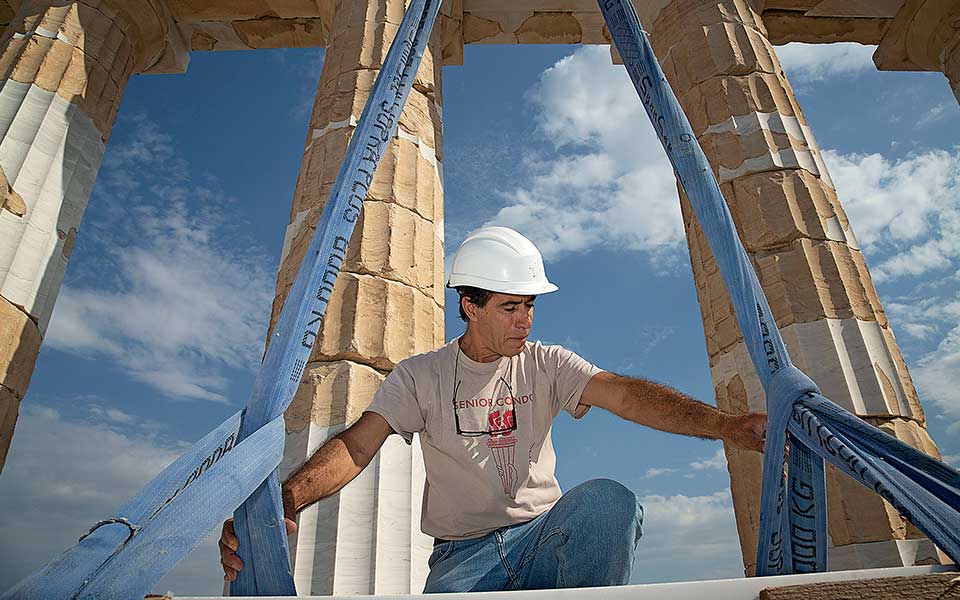
© Nikos Pilos
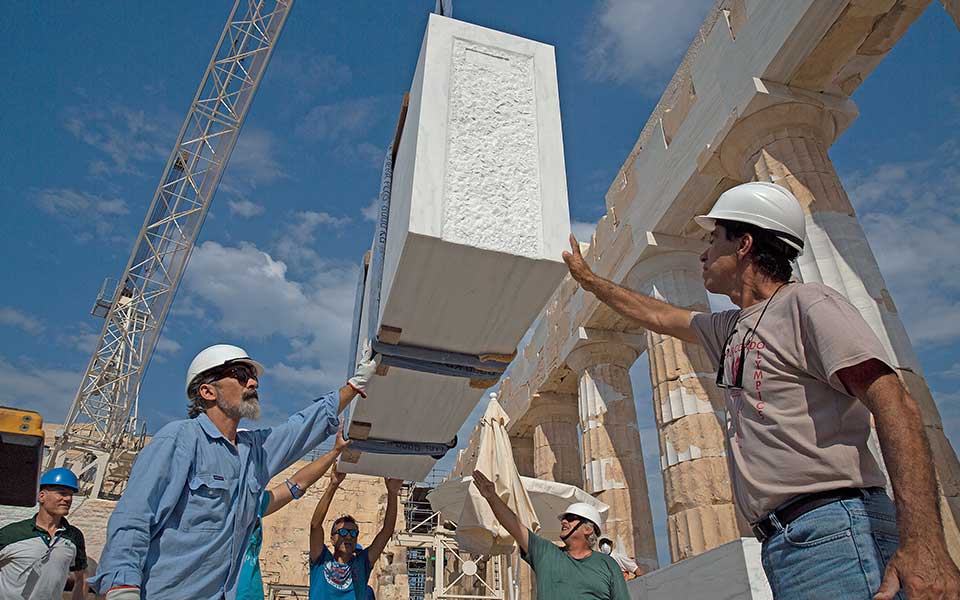
© Nikos Pilos
Under Attack
Why is it that the Parthenon needs to be rebuilt in the first place? It all began in 1687, with the bombardment by Francesco Morosini’s forces, when large parts of the Parthenon’s cella walls collapsed. They remained in that state until 1822, when the Greeks, in the struggle for their independence, besieged Turkish troops on the Acropolis. The Turkish soldiers, running out of bullets, discovered that there was lead between the marble blocks, and so they knocked down the rest of the cella walls. The lead they found, explains Eleftheriou, had been used by the ancient architects “to protect iron clamps from corrosion.
All the marble blocks that were removed then remained in the immediate area. Quite a few were used by archaeologist Kyriakos Pittakis and architect Nikolaos Balanos in the 19th and 20th centuries, when the cella’s north and south walls were partly restored, but incorrectly. In 1992-1993, the parts that had been erroneously restored were dismantled and the material studied, so now we know the true positions that about 190 marble members originally had within the north wall. In addition, 170 other members are known to belong to the north wall, although we’re not sure at what height they were originally laid.”
Concurrent to the works on the cella’s north wall, the YSMA’s final implementation study for the south wall is already in progress. The restoration of these two walls will help to put back into place most of the ancient marble blocks now scattered about the archaeological site. In addition, the outline of the cella will be defined. The walls will provide a background to the columns; visitors will have a more complete picture of the temple.
“Certainly, this has been a time-consuming project,” says the YSMA director. She recalls the long struggle of the late architect Charalambos Bouras, former ESMA president, for the advancement of this program concerning the long walls of the Parthenon’s cella.
This extensive project will take another 15 years but, “because the work will be done inside the Parthenon,” says Eleftheriou, “no scaffolding will be visible on the sides of the monument.”
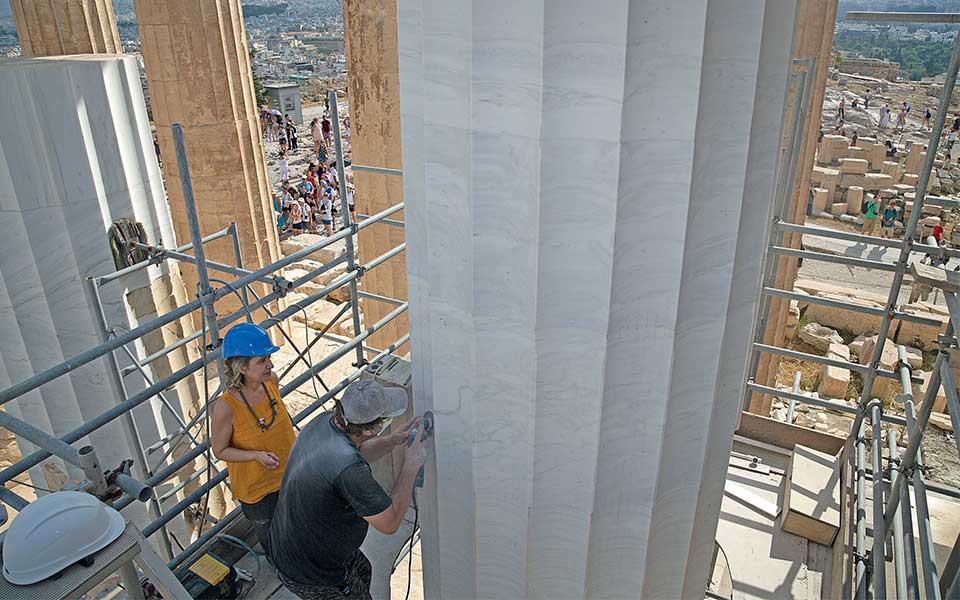
© Nikos Pilos
Those dealing with the restoration of the Acropolis monuments always point to the fact that most of the catastrophic damage visible today is due to human intervention: bombardments, fires, military takeovers and sub-standard restorations. But how protected is the Acropolis from the anger of Enceladus, the leader of the Giants who shakes the earth, according to ancient Greek mythology? Or, put another way, how much of a threat is seismic activity?
Since 2009, in collaboration with Mie University in Japan, a program has been in effect to study the earthquake behavior of the Acropolis monuments. YSMA’s director when this program started was civil engineer Mary Ioannidou, who oversaw the placement of accelerometers on the Parthenon, in conjunction with the National Technical University of Athens, to monitor seismic vibrations and the subsequent reactions of the ancient monuments. Japanese scholars, including Prof.Toshikazu Hanazato, believe that traditional wooden pagodas have structural characteristics that match those of the Parthenon’s marble columns.
Ten more accelerometers have been installed on the Acropolis, at the hill’s foot and at its summit, in collaboration with the Institute of Geodynamics of the Greek National Observatory, where a database is being systematically accumulated. There is a great deal of interest in the anti-earthquake secrets of the Acropolis.
The atmospheric pollution in Athens that kept scientists so busy in the 1970s is no longer a major worry. “Pollution levels here have decreased with changes in automobile technology, the construction of the metro, and other factors,” Eleftheriou says. “Today, we’re more concerned with climate change issues and the current phenomenon of unpredictable weather. This is a concern for YSMA and the Athenian Ephorate of Antiquities. It requires a centralized strategy for all the monuments.”
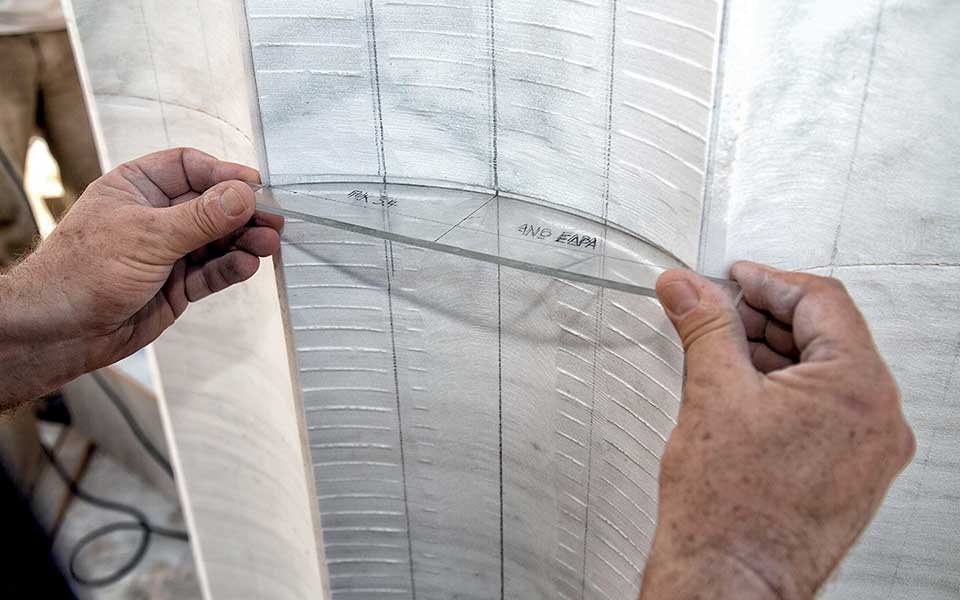
© Nikos Pilos
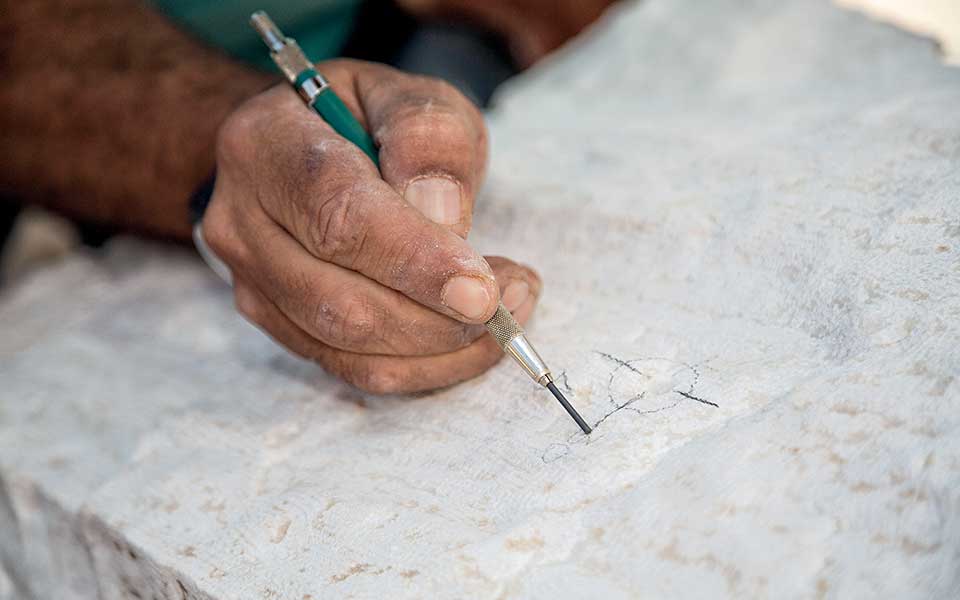
© Nikos Pilos
The Acropolis has no problem with floods, says Eleftheriou, “but we do have to deal with rainwater. At some locations, the water tends to pool or run unchecked, so it erodes the ground and we have problems with the ancient walls and the hill in general. Examining this issue is among the next studies we want to undertake.”
And what of the question most often asked: will the Acropolis ever be free of scaffolding and construction sites? “In 2015,” Eleftheriou says, “we had scaffolding on the Propylaia, on the Parthenon’s west side and covering the Temple of Athena Nike. Today, though, the only thing that mars our view are the works on the west side of the Parthenon.”
From Lindos to Athens
Eleftheriou speaks at length, sometimes lapsing into difficult technical terms, but she’s generously patient as she explains her work, which also involves coordinating and overseeing engineers, architects, marble masons and workers. She goes up to the Acropolis worksite once or twice a week; on other days, she works out of YSMA’s neoclassical headquarters nearby. She oversees the work of 114 specialist employees on loan from other departments of the Ministry of Culture, as well as 40 employees hired under the EU’s NSRF 2014-2020 program.
How, I ask Eleftheriou, does she manage all this? “Perhaps it’s because I came into this young,” she replies. As an architect-engineer who graduated from the National Technical University of Athens with a master’s degree in the protection of monuments and the restoration and reconstruction of historic buildings and sites, she has been an employee of the Ministry of Culture since 1988. Until 2005, she was the director of restoration works for the Lindos Acropolis monuments on Rhodes. “There, I had a construction site with a ten-person crew; it wasn’t that different, really. By the time I left, I had 35 people.”
What was their reaction, I ask, when she showed up on the worksite in the blistering heat for the first time at the age of 27? “They were surprised,” she says, laughing, “but I never felt uncomfortable because there was a program and cooperation. I was sent to work on the Parthenon restoration project in 2005. It wasn’t my goal to be the head of a service. I’d worked at YSMA for years and was next in line, in terms of seniority, when the previous head retired.”
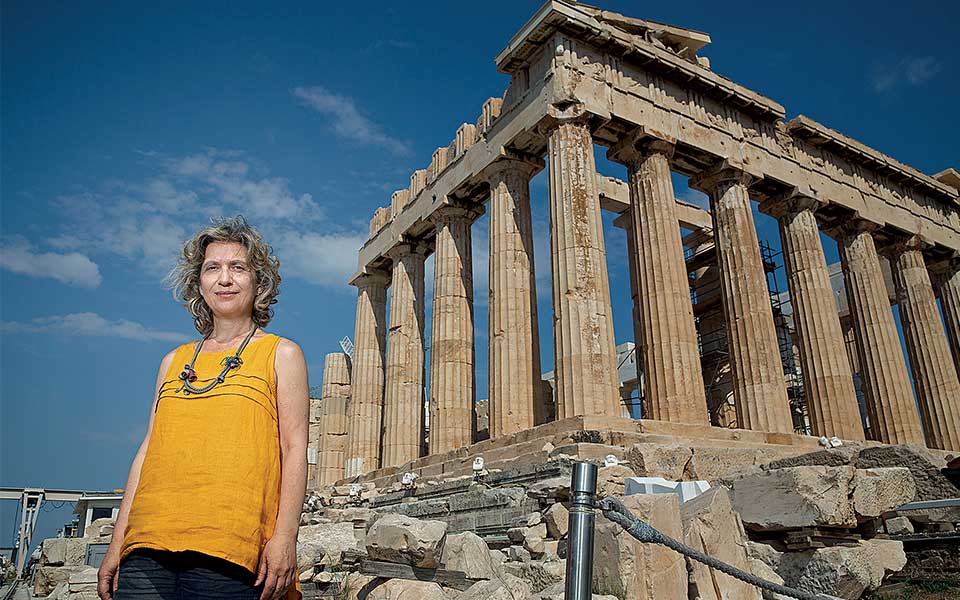
© Nikos Pilos
It was an appreciation for geometry, mathematics and painting that led Eleftheriou to architecture. “I’m an organized person, but never seem to have enough time. I wasn’t an excellent student, but I was a good one, with discipline and perseverance.” Born in Sparta to parents from Evia, she studied in Athens and took her first professional steps in Rhodes. “Ancient monuments hold a charm for me; it’s the history they carry. In school, I leaned mostly toward Byzantium. I began dealing with Classical antiquities because of my duties at Lindos. They drew me in. Charalambos Bouras was an excellent teacher. He was also on the Lindos oversight committee.” She also has only good words to say about her mentors Manolis Korres, Kostas Zambas and Fani Mallouchou-Tufano, and about the heads of the Committee for the Restoration of Lindos Acropolis Monuments, Eos Zervoudaki, and Dodecanese Archaeological Service, Gregory Constantinopoulos.
Today, as YSMA director, she says that the daily throng of visitors to the Acropolis keeps her particularly busy: the site covers six hectares and receives about two million visitors annually. “We have some ideas about how we can deal with this better, but it’s difficult to maintain enough open space to allow so many people to come and go, especially when the summer cruise ship visitors arrive. We also must think about the monuments.”
What does she want her legacy to be? “Don’t expect any great pronouncements. I came into this position in late 2011, when the economic crisis in Greece had just started. Wages and benefits had been cut and things were difficult.” Yet, despite the hardships they faced, like the whole country, they soldiered on. “I look forward to helping our team carry on with the same appetite and passion.” Speaking of YSMA, Eleftheriou says “We’re not talking about a typical public organization here, although we are state-run. The state took care to set up a special service for the Acropolis monuments and to set high standards that we should strive to meet. Going forward, I’d like to remain faithful to the way we work as a team, and to continue the excellent work of our teachers.”

